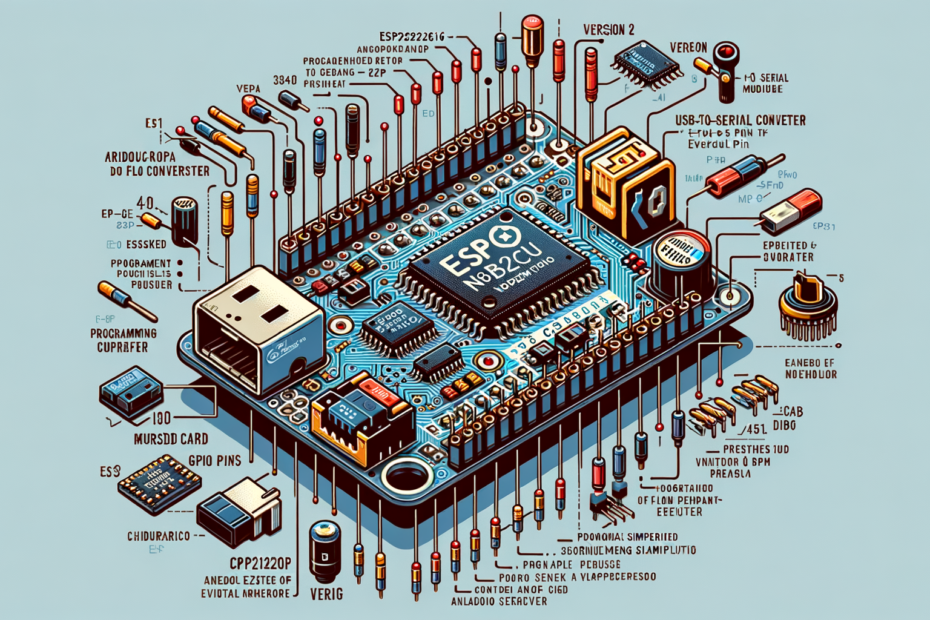The ESP8266 has become a superstar in the world of Internet of Things (IoT) development. This tiny Wi-Fi microcontroller packs a powerful punch, allowing you to bring your connected projects to life. But with a variety of ESP8266 development boards available, choosing the right one can be daunting. Fear not, intrepid makers! This guide dives deep into the features, pros, and cons of popular ESP8266 boards, equipping you to make an informed decision for your next project.
The ubiquitous NodeMCU
The NodeMCU is a ubiquitous ESP8266 board beloved for its ease of use. At its heart lies the ESP-12E module with a generous 4MB of flash memory. The built-in USB-to-Serial converter (CP2102 in v2, CH340 in v3) streamlines programming directly from the Arduino IDE or PlatformIO. An onboard Analog-to-Digital Converter (ADC) lets you integrate analog sensors, while multiple GPIO pins (usually 9 or more) provide ample space for connecting various sensors and actuators. Power stability is ensured by a voltage regulator, and some models even boast a microSD card slot for additional storage.
Why NodeMCU Shines:
- Beginner-Friendly: Programmable directly from familiar platforms like Arduino IDE.
- Open-Source Power: The NodeMCU firmware empowers you to fully customize your project.
- GPIO Galore: Ample pins handle complex projects with multiple sensors and actuators.
- Community Strong: Extensive documentation and a large online community offer valuable support.
NodeMCU’s Achilles’ Heel:
- Size Matters: Compared to some boards, the NodeMCU’s footprint can be larger.
- Power Play: Its higher power consumption might not be ideal for battery-powered projects.
The WeMos D1 Mini: Small But Mighty
The WeMos D1 Mini stands out for its compact and lightweight design, making it perfect for space-constrained projects.This little powerhouse features an ESP-8266EX module with 4MB of flash memory. The focus here is on efficiency, with lower power consumption ideal for battery-powered applications. A built-in voltage regulator ensures stable power, and multiple GPIO pins (typically 8) allow you to connect various sensors and actuators.
Why the WeMos D1 Mini Mini Wins You Over:
- Size Does Matter: Its compact design is perfect for tight spaces.
- Battery Friendly: Lower power consumption makes it ideal for on-the-go projects.
- Easy on the Wallet: Often more affordable than some other options.
- Familiar Footing: Programmable using Arduino IDE or PlatformIO.
Things to Consider with the WeMos D1 Mini:
- Pin Count Caution: Fewer GPIO pins might limit the complexity of your project.
- Programming Puzzle: Some models might require an additional USB-to-Serial converter.
- Community Calling: The community is smaller compared to the NodeMCU.
Beyond the Usual Suspects: Exploring Other ESP8266 Options
The world of ESP8266 extends beyond these two popular choices. Let’s explore some additional noteworthy boards:
- ESP-12E Module: This compact and low-cost barebones module is ideal for experienced users who want a customizable base for integrating ESP8266 into larger projects.
- LOLIN Boards: These versatile boards offer a range of options, including integrated OLED displays for data visualization, prototyping areas for easy component integration, and built-in LiPo battery charging for portable projects.
- Adafruit Feather HUZZAH ESP8266: This pre-assembled board comes with extras like a battery connector, level shifter, and user button, making it perfect for beginners with minimal setup required.
Choosing Your ESP866 Champion
To help you pick the perfect board for your project, here’s a handy guide:
- Project Complexity: For intricate projects with multiple components, the NodeMCU’s ample GPIO pins reign supreme. The WeMos D1 Mini excels for simpler tasks.
- Size and Weight Constraints: When space is at a premium, the WeMos D1 Mini or ESP-12E are your best bets.
- Power Consumption: Battery-powered projects benefit from the WeMos D1 Mini or ESP-12E’s lower power draw.
- Need for Extra Features: Consider LOLIN boards for displays or Feather HUZZAH for beginner-friendliness.
The Final Word
Each ESP8266 board has its own strengths and weaknesses. By understanding these factors and considering your project’s specific needs, you’ll be well on your way to
